History
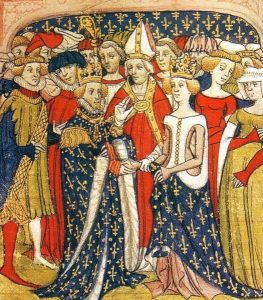 Most people think that English came from England, and of course, it did, however, in England prior to the 19th century, the English language was not spoken by the aristocracy, but rather only by “commoners.” Back then, English used to belong to the people, and I suppose that might explain some of the “incorrect” uses of the language which have been so severely attacked by contemporary English speakers. Prior to the 19th century, the aristocracy in English courts spoke French. This was due to the Norman Invasion of 1066 and caused years of division between the “gentlemen” who had adopted the Anglo-Norman French and those who only spoke English. Even the famed King Richard the Lionheart was actually primarily referred to in French, as Richard “Coeur de Lion.”
Most people think that English came from England, and of course, it did, however, in England prior to the 19th century, the English language was not spoken by the aristocracy, but rather only by “commoners.” Back then, English used to belong to the people, and I suppose that might explain some of the “incorrect” uses of the language which have been so severely attacked by contemporary English speakers. Prior to the 19th century, the aristocracy in English courts spoke French. This was due to the Norman Invasion of 1066 and caused years of division between the “gentlemen” who had adopted the Anglo-Norman French and those who only spoke English. Even the famed King Richard the Lionheart was actually primarily referred to in French, as Richard “Coeur de Lion.”
In my opinion, this dual language society would have caused numerous problems. The indication I get is that neither side could speak the language of the other, but I don’t know how a monarchy could rule, if the “commoners” could not understand the language and therefore the orders of the monarchy. French was spoken and learned by anyone in the upper 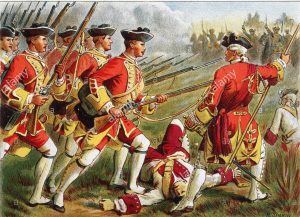 classes. However, it became less useful as English lost its control of various places in France, where the peasants spoke French, too. After that…about, 1450…English was simply more useful for talking to anybody. It is still true that British royals and many nobles are fluent in French, but they only use it to talk to French people, just like everybody else.
classes. However, it became less useful as English lost its control of various places in France, where the peasants spoke French, too. After that…about, 1450…English was simply more useful for talking to anybody. It is still true that British royals and many nobles are fluent in French, but they only use it to talk to French people, just like everybody else.
To further confuse your preconceptions about the English language, the “British accent” was, in reality, created after the Revolutionary War, meaning contemporary Americans sound more like the colonists and British soldiers of the 18th century than contemporary Brits. Many people have made a point of how much they love the British accent, but I think very few people know the real story behind the British accent. In the 18th century and before, the British “accent” was the way we speak herein America. Of course, accents vary greatly  by region, as we have seen with the accents of the south and east in the United States, but the “BBC English” or public school English accent…which sounds like the James Bond movies…didn’t come about until the 19th century and was originally adopted by people who wanted to sound fancier. I suppose it was like the aristocracy and the commoners, in that one group didn’t want to be mistaken for the other. After being handily defeated by the American colonists, I’m sure that the British were looking for a way to seem superior, even in defeat. The change in the accent of the English language was sufficient to make that distinction. Maybe it was their way of saying that they were better than the American guerilla-type soldiers who beat them in combat…basically they might have lost, but they were superior…even if it was only in how they sounded.
by region, as we have seen with the accents of the south and east in the United States, but the “BBC English” or public school English accent…which sounds like the James Bond movies…didn’t come about until the 19th century and was originally adopted by people who wanted to sound fancier. I suppose it was like the aristocracy and the commoners, in that one group didn’t want to be mistaken for the other. After being handily defeated by the American colonists, I’m sure that the British were looking for a way to seem superior, even in defeat. The change in the accent of the English language was sufficient to make that distinction. Maybe it was their way of saying that they were better than the American guerilla-type soldiers who beat them in combat…basically they might have lost, but they were superior…even if it was only in how they sounded.
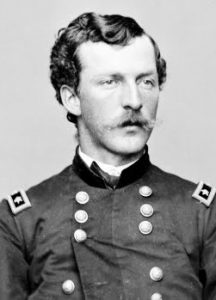
 Who shot first? We will never know, but on December 29, 1890, that first shot started a massacre. What lead up to that fateful day? For all of his 27 years, Black Elk’s had watched as the way of life of the Lakota Sioux on the Great Plains was taken away. Black Elk was a medicine man, who witnessed years of broken treaties. He watched as the white men “came in like a river” when gold was discovered in the Dakota Territory’s Black Hills in 1874. He was there two years later when Custer and his men were annihilated at Little Big Horn. He saw the Lakota’s traditional hunting grounds evaporate as white men decimated the native buffalo population. The Lakota, who once roamed as free as the bison on the Great Plains, were now mostly confined to government reservations.
Who shot first? We will never know, but on December 29, 1890, that first shot started a massacre. What lead up to that fateful day? For all of his 27 years, Black Elk’s had watched as the way of life of the Lakota Sioux on the Great Plains was taken away. Black Elk was a medicine man, who witnessed years of broken treaties. He watched as the white men “came in like a river” when gold was discovered in the Dakota Territory’s Black Hills in 1874. He was there two years later when Custer and his men were annihilated at Little Big Horn. He saw the Lakota’s traditional hunting grounds evaporate as white men decimated the native buffalo population. The Lakota, who once roamed as free as the bison on the Great Plains, were now mostly confined to government reservations.
Life for the Sioux was very bleak during the winter of 1890. Then came a glimmer of hope with the new Ghost Dance spiritual movement, which preached that Native Americans had been confined to reservations because they had angered the gods by abandoning their traditional customs. Leaders promised that the buffalo would return, relatives would be resurrected and the white man would be cast away if the Native Americans performed a ritual “ghost dance.” Such a ritual was seriously scary for the “white man.” The settlers grew increasingly alarmed and worried that an uprising was coming. “Indians are dancing in the snow and are wild and crazy,” telegrammed a frightened government agent stationed on South Dakota’s Pine Ridge Reservation to the commissioner of Indian affairs on November 15, 1890. “We need protection and we need it now.”
General Nelson Miles arrived with 5,000 troops as part of the Seventh Cavalry, which was Custer’s old command. He ordered the arrest of several Sioux leaders. When Indian police tried to arrest Chief Sitting Bull, who was mistakenly believed to have been joining the Ghost Dancers, the noted Sioux leader was killed in the melee. Then, on December 28, the cavalry caught up with Chief Big Foot, who was leading a band of upwards of 350 people to join Chief Red Cloud, near the banks of Wounded Knee Creek. The American forces arrested Big Foot, who was too ill with pneumonia to sit up, let alone walk, and positioned their Hotchkiss guns on a rise overlooking the Lakota camp. As a bugle blared the following morning, December 29, American soldiers mounted their horses and surrounded the Native American camp. A medicine man who started to perform the ghost dance cried out, “Do not fear but let your hearts be strong. Many soldiers are about us and have many bullets, but I am assured their bullets cannot penetrate us.” He implored the heavens to scatter the soldiers like the dust he threw into the air.
The cavalry went teepee to teepee seizing axes, rifles and other weapons. As the soldiers attempted to confiscate a weapon they spotted under the blanket of a deaf man, who could not hear their orders, a gunshot suddenly rang out. It was not clear which side shot first, but within seconds the American soldiers launched a hail of bullets from rifles, revolvers and rapid-fire Hotchkiss guns into the teepees. Outnumbered and 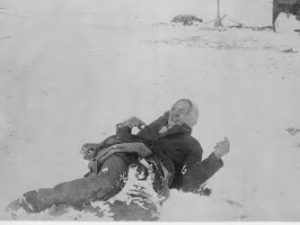
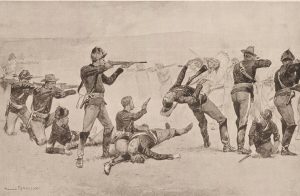 outgunned, the Lakota offered meek resistance. Big Foot was shot where he lay on the ground. Boys who had been happily playing leapfrog were mowed down. In just a matter of minutes, at least 150 Lakota Sioux Indians were killed along with 25 American soldiers. Half the victims were women and children. The soldiers might have thought they were being attacked…it’s hard to say. Nevertheless, that first shot brought about a massacre.
outgunned, the Lakota offered meek resistance. Big Foot was shot where he lay on the ground. Boys who had been happily playing leapfrog were mowed down. In just a matter of minutes, at least 150 Lakota Sioux Indians were killed along with 25 American soldiers. Half the victims were women and children. The soldiers might have thought they were being attacked…it’s hard to say. Nevertheless, that first shot brought about a massacre.

 Travel by ship was not always a safe mode of travel. Things like icebergs, wars, storms, and seashores were known to bring to an end a voyage, that was otherwise very enjoyable. Most people remember the Unsinkable Molly Brown, who was really Margaret Tobin, mostly because of all the publicity and even a musical. Surviving the sinking of the Titanic, while an amazing feat, was something that 705 other people did too. The stories and musical were a way of remembering the tragedy. As amazing as surviving a ship sinking in those days was, there is something that is far more amazing!!
Travel by ship was not always a safe mode of travel. Things like icebergs, wars, storms, and seashores were known to bring to an end a voyage, that was otherwise very enjoyable. Most people remember the Unsinkable Molly Brown, who was really Margaret Tobin, mostly because of all the publicity and even a musical. Surviving the sinking of the Titanic, while an amazing feat, was something that 705 other people did too. The stories and musical were a way of remembering the tragedy. As amazing as surviving a ship sinking in those days was, there is something that is far more amazing!!
Surviving, not one, but three ship accidents in those days. In 1910, Violet Jessop began working as an ocean liner stewardess and nurse for the White Star line. She was on board when RMS Olympic sailed on September 20, 1911. The Olympic was a luxury ship that was the largest civilian liner at that time. Olympic left from Southampton and collided with the British warship HMS Hawke. There were no fatalities when Olympic sand, and despite damage, the ship was able to make it back to port without sinking. She doesn’t really count this one, because it didn’t sink, but then it did collide with another ship. She didn’t think that one was such an amazing feat, but I’d say that counts. Jessop was then a stewardess on the RMS Titanic April 10, 1912, when she was 24 years old. Four days later, on April 14, it struck an iceberg in the North Atlantic, a story with we all know very well. Titanic sank a little more than two hours after the collision. Jessop described in her memoirs how she was ordered up on deck, because she was to function as an example of how to behave for the non-English speakers who could not follow the instructions given to them. She watched as the crew loaded the lifeboats. She was later ordered into lifeboat 16; and as the boat was being lowered, one of the Titanic’s officers gave her a baby to look after. The next morning, Jessop and the rest of the survivors were rescued by the RMS Carpathia. According to Jessop, while on board the Carpathia, a woman, presumably the baby’s mother, grabbed the baby she was holding and ran off with it without saying a word. Records indicate that the only baby on boat 16 was Assad Thomas, who was handed to Edwina Troutt, and later reunited with his mother on the Carpathia. Then, during the First World War, she served as a stewardess for the British Red Cross. On the morning of November 21, 1916, she was on board the HMHS Britannic, that had been converted into a hospital ship, when it sank in the Aegean Sea due to an unexplained explosion. The Britannic sank within 57 minutes, killing 30 people. British authorities decided that the ship was either struck by a torpedo or hit a mine planted by German forces.
After the war, Jessop continued to work for the White Star Line, before joining the Red Star Line and then the 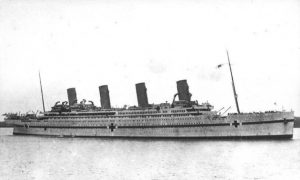
 Royal Mail Line again. During her tenure with Red Star, Jessop went on two around the world cruises on that company’s largest ship, the Belgenland. In her late thirties, Jessop had a brief marriage, and in 1950 she retired to Great Ashfield, Suffolk, where my dad had been stationed during World War II. Jessop, often winkingly called “Miss Unsinkable,” died of congestive heart failure in 1971 at the age of 83.
Royal Mail Line again. During her tenure with Red Star, Jessop went on two around the world cruises on that company’s largest ship, the Belgenland. In her late thirties, Jessop had a brief marriage, and in 1950 she retired to Great Ashfield, Suffolk, where my dad had been stationed during World War II. Jessop, often winkingly called “Miss Unsinkable,” died of congestive heart failure in 1971 at the age of 83.
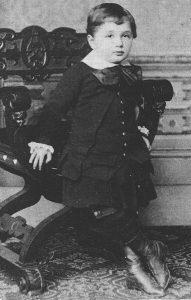 Albert Einstein has always been one of my favorite historic figures, so I decided to look for more information on him. I was surprised about some of the things I found out. Albert Einstein was born in Ulm, Germany in 1879, to parents Hermann Einstein and Pauline Einstein. Albert had a large head at the time he was born, so large, in fact that it startled his mother and grandmother when they saw him for the first time. The “fat” head slowly receded and turned into a normal size. Strangely, the head containing the brain of an amazing historic genius, was not so perfect at birth. Einstein did not speak until the age of three, odd for a genius. He revealed this fact about himself in his biography. Today there is a term, “Einstein Syndrome,” which was coined by Dr. Thomas Sowell, to describe exceptionally bright people whose speech is delayed. Einstein spent his teenage years in Munich, where his family operated an electrical equipment business. Galileo Galilei was Einstein’s favorite scientist.
Albert Einstein has always been one of my favorite historic figures, so I decided to look for more information on him. I was surprised about some of the things I found out. Albert Einstein was born in Ulm, Germany in 1879, to parents Hermann Einstein and Pauline Einstein. Albert had a large head at the time he was born, so large, in fact that it startled his mother and grandmother when they saw him for the first time. The “fat” head slowly receded and turned into a normal size. Strangely, the head containing the brain of an amazing historic genius, was not so perfect at birth. Einstein did not speak until the age of three, odd for a genius. He revealed this fact about himself in his biography. Today there is a term, “Einstein Syndrome,” which was coined by Dr. Thomas Sowell, to describe exceptionally bright people whose speech is delayed. Einstein spent his teenage years in Munich, where his family operated an electrical equipment business. Galileo Galilei was Einstein’s favorite scientist.
Albert Einstein’s lifelong love of science and math is no big secret, and in fact is what made him famous, that and his well know genius. That said, I was stunned to find out that his teachers did not  consider him a good student, and they refused to recommend him for further employment. It is said that at 16, Einstein failed an exam that would have allowed him train to become an electrical engineer. One of the things I found to be the most interesting is that Albert Einstein had a poor memory. He could not remember names, dates or phone numbers. I heard that he didn’t see the need to remember what he could have written down. Maybe this was why it needed to be written down. Most people know that he was given the Nobel Prize in 1921. It was the Nobel Prize in Physics that was awarded to Albert Einstein “for his services to Theoretical Physics, and especially for his discovery of the law of the photoelectric effect.” But, Einstein had a funny side too, and would have fit right in with the kids of today…at least in his picture taking. I really it wasn’t a selfie, but as selfies go, it fit right in with that the kids of today are doing, and apparently he though it was just as funny as they do. He was sure pleased with this one.
consider him a good student, and they refused to recommend him for further employment. It is said that at 16, Einstein failed an exam that would have allowed him train to become an electrical engineer. One of the things I found to be the most interesting is that Albert Einstein had a poor memory. He could not remember names, dates or phone numbers. I heard that he didn’t see the need to remember what he could have written down. Maybe this was why it needed to be written down. Most people know that he was given the Nobel Prize in 1921. It was the Nobel Prize in Physics that was awarded to Albert Einstein “for his services to Theoretical Physics, and especially for his discovery of the law of the photoelectric effect.” But, Einstein had a funny side too, and would have fit right in with the kids of today…at least in his picture taking. I really it wasn’t a selfie, but as selfies go, it fit right in with that the kids of today are doing, and apparently he though it was just as funny as they do. He was sure pleased with this one.
One of the most interesting things I found out was that Einstein was offered the opportunity to become  president of Israel after the its first president died in 1952. Einstein politely refused the offer, saying that he did not have the natural aptitude and experience to deal with people properly. He said that he could only understand a little of science and none of human nature. A little of science!!! Really!! I suppose that a genius would know and realize that just like the Bible, our understanding of science has only scratched the surface. Sadly, Albert Einstein had a “practical” view, if you will, of human life. He could have lived longer than he did. But, before he died, doctors suggested surgery to Einstein, because he suffered from a burst blood vessel. However, Einstein refused, stating, “It is tasteless to prolong life artificially.” I don’t understand why he ended such brilliance by refusing an operation that could save him. I find that very sad.
president of Israel after the its first president died in 1952. Einstein politely refused the offer, saying that he did not have the natural aptitude and experience to deal with people properly. He said that he could only understand a little of science and none of human nature. A little of science!!! Really!! I suppose that a genius would know and realize that just like the Bible, our understanding of science has only scratched the surface. Sadly, Albert Einstein had a “practical” view, if you will, of human life. He could have lived longer than he did. But, before he died, doctors suggested surgery to Einstein, because he suffered from a burst blood vessel. However, Einstein refused, stating, “It is tasteless to prolong life artificially.” I don’t understand why he ended such brilliance by refusing an operation that could save him. I find that very sad.
 The Christmas rush is behind us for another year. The gifts are purchased, and wrapped, and for many people, already opened. Christmas dinner is being prepared and families are gathering together. The house is filled with laughter and conversation and stomachs are growling just a bit as the aroma of the turkey fills the air. It’s hard to wait for the meal to be ready. It’s such a wonderful time to be sharing with family. Many people think of these big dinners as a lot of work, and it can be almost a relief to have them over, but really, they are a gift. All to quickly, children grow up and sometimes, move away, and before you can even blink, everything has changed. All the more reason to cherish the times you have, while you have them.
The Christmas rush is behind us for another year. The gifts are purchased, and wrapped, and for many people, already opened. Christmas dinner is being prepared and families are gathering together. The house is filled with laughter and conversation and stomachs are growling just a bit as the aroma of the turkey fills the air. It’s hard to wait for the meal to be ready. It’s such a wonderful time to be sharing with family. Many people think of these big dinners as a lot of work, and it can be almost a relief to have them over, but really, they are a gift. All to quickly, children grow up and sometimes, move away, and before you can even blink, everything has changed. All the more reason to cherish the times you have, while you have them.
So much has changed since the Christmases of my youth, and while I wouldn’t go back, because then I wouldn’t have my precious daughters, sons-in-law, grandchildren, and now the new little great grandbaby that is on the way in late spring 2018. But, I do wish my parents, Allen and Collene Spencer 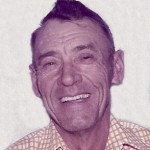
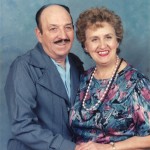 were still here. Having them in Heaven brings a little bit of a melancholy feeling to an otherwise cheerful season. Nevertheless, knowing that they are spending their days in Heaven with Jesus…the reason for this season, makes me feel very happy for them, even if I’m sad for me. It has been 10 Christmases since I have seen my dad, and 3 Christmases since I’ve seen my mom, as well as, 5 Christmases since I’ve seen my father-in-law, Walt Schulenberg. It’s odd, I suppose to think of how many Christmases they have been gone, but they were such a big part of what Christmas was for me, as well as every day of my life, that I find it really hard not to contemplate the fact that so much has changed in the years since they left, and just how much we miss them.
were still here. Having them in Heaven brings a little bit of a melancholy feeling to an otherwise cheerful season. Nevertheless, knowing that they are spending their days in Heaven with Jesus…the reason for this season, makes me feel very happy for them, even if I’m sad for me. It has been 10 Christmases since I have seen my dad, and 3 Christmases since I’ve seen my mom, as well as, 5 Christmases since I’ve seen my father-in-law, Walt Schulenberg. It’s odd, I suppose to think of how many Christmases they have been gone, but they were such a big part of what Christmas was for me, as well as every day of my life, that I find it really hard not to contemplate the fact that so much has changed in the years since they left, and just how much we miss them.
While the commercialized part of Christmas is about giving and receiving gifts from loved ones, it is the  ultimate gift that really is what Christmas is all about. I don’t know what other people think about gift giving, but for me, it is God’s children imitating the Father. God gave us the ultimate gift, when He sent His son, and Jesus gave us the ultimate gift when He gave His life for us. We can never give a gift that could begin to compare to the precious gift that God gave us, but it is a show of our love for each other, and I know that makes God happy. He wanted His children to love each other, just as He so loved the world. I’m thankful for the coming of our Lord and Saviour, Jesus Christ, and for the price He later paid, because without Him none of us would receive Heaven when we passed away. That you Father for your precious gift, and thank you Jesus for paying my debt. Happy birthday Jesus. We love you!!
ultimate gift that really is what Christmas is all about. I don’t know what other people think about gift giving, but for me, it is God’s children imitating the Father. God gave us the ultimate gift, when He sent His son, and Jesus gave us the ultimate gift when He gave His life for us. We can never give a gift that could begin to compare to the precious gift that God gave us, but it is a show of our love for each other, and I know that makes God happy. He wanted His children to love each other, just as He so loved the world. I’m thankful for the coming of our Lord and Saviour, Jesus Christ, and for the price He later paid, because without Him none of us would receive Heaven when we passed away. That you Father for your precious gift, and thank you Jesus for paying my debt. Happy birthday Jesus. We love you!!
 As people prepare for Christmas, their days are busy shopping for gifts, and buying things for Christmas dinner. Their minds are on friends, family, and the coming holiday…not disaster. On December 23, 1982, disaster came in the form of a chemical…dioxin, which had been sprayed on the unpaved roads in the town of Times Beach, Missouri. On the 23rd, just two days before Christmas the Missouri Department of Health and the federal Centers for Disease Control (CDC) informed the residents that their town would have to be evacuated. They were told that not only would their town have to be evacuated, but it would also have to be demolished. It was a nightmare Christmas for the people of the town of about 2,000 people. These were their homes, and now the government was telling them that they had to leave. Sure they were offered money, and a chance to relocate somewhere, but some of the residents had lived there all their lives. They just didn’t want to leave. Some refused to sell. By February, the federal and state governments had spent $36 million to buy every house in town except one. Eventually, in 1985, there was only one couple left living in the town, George and Lorene Klein. People magazine profiled their last stand. “They wanted more money,” Leistner says. “She still blames me. I didn’t set the price, but it’s my fault. She doesn’t speak to me.” In 1985, the city was officially disincorporated.
As people prepare for Christmas, their days are busy shopping for gifts, and buying things for Christmas dinner. Their minds are on friends, family, and the coming holiday…not disaster. On December 23, 1982, disaster came in the form of a chemical…dioxin, which had been sprayed on the unpaved roads in the town of Times Beach, Missouri. On the 23rd, just two days before Christmas the Missouri Department of Health and the federal Centers for Disease Control (CDC) informed the residents that their town would have to be evacuated. They were told that not only would their town have to be evacuated, but it would also have to be demolished. It was a nightmare Christmas for the people of the town of about 2,000 people. These were their homes, and now the government was telling them that they had to leave. Sure they were offered money, and a chance to relocate somewhere, but some of the residents had lived there all their lives. They just didn’t want to leave. Some refused to sell. By February, the federal and state governments had spent $36 million to buy every house in town except one. Eventually, in 1985, there was only one couple left living in the town, George and Lorene Klein. People magazine profiled their last stand. “They wanted more money,” Leistner says. “She still blames me. I didn’t set the price, but it’s my fault. She doesn’t speak to me.” In 1985, the city was officially disincorporated.
Originally founded in 1925, Times Beach was actually part of a newspaper promotion: A 6-month subscription  to The St. Louis Times plus an extra $67.50 bought a 20-by-100–foot lot along an unsettled stretch of the Meramec River. The town never became the booming resort that the newspaper had intended it to be, but rather, it evolved into a lower-middle–class hamlet of about 2,000 people. It was located just off Route 66, the now famous two lane highway that ran from Chicago to Los Angeles, and was once was one of the major routes across the American Southwest. Unfortunately, being the small town that it was, Times Beach never had the money to pave its roads, and all the dust that was kicked up by vehicles was a real nuisance. In 1972, town officials thought they’d found a perfect solution to the problem: they paid local waste-hauler Russell Bliss just 6 cents per gallon to spray its roads with oil. The plan was to basically glue the dust to the ground, but we all know about the best laid plans. They had hoped the oil mixture would mix with the dirt and somehow glue it down. They never anticipated the problem the “cheaper solution” would cause.
to The St. Louis Times plus an extra $67.50 bought a 20-by-100–foot lot along an unsettled stretch of the Meramec River. The town never became the booming resort that the newspaper had intended it to be, but rather, it evolved into a lower-middle–class hamlet of about 2,000 people. It was located just off Route 66, the now famous two lane highway that ran from Chicago to Los Angeles, and was once was one of the major routes across the American Southwest. Unfortunately, being the small town that it was, Times Beach never had the money to pave its roads, and all the dust that was kicked up by vehicles was a real nuisance. In 1972, town officials thought they’d found a perfect solution to the problem: they paid local waste-hauler Russell Bliss just 6 cents per gallon to spray its roads with oil. The plan was to basically glue the dust to the ground, but we all know about the best laid plans. They had hoped the oil mixture would mix with the dirt and somehow glue it down. They never anticipated the problem the “cheaper solution” would cause.
Bliss got the oil for free the year before, when a chemical manufacturer that had made most of its money selling napalm to the military paid him to get rid of its waste materials. He mixed six truckloads of that waste…which turned out to be hexachlorophene tainted with dioxin, a dangerous chemical that, once absorbed, can remain in the human body for more than 10 years–with a tankful of used motor oil. Next, he sprayed this carcinogenic cocktail all over town. The children of Times Beach loved sliding around in Bliss’ purple-tinted goo, 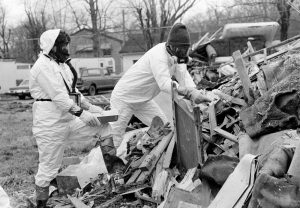 and no one gave the substance a second thought until animals…particularly horses, who had contact with Bliss-sprayed roads and barn floors and riding rings every day, all year round…started dropping dead. Soon people started to get sick, too. In 1979, the EPA came to town and took soil samples, and in 1982 the agency announced that the levels of dioxin, “the most potent cancer-causing agent made by man,” in Times Beach were off the charts. The agency evacuated the town just after Christmas. In all, the agency spent $250 million and incinerated 265,000 tons of dioxin-tainted soil. In 1999, the bulldozed and cleaned-up Times Beach reopened as the Route 66 State Park. Times Beach has remained a Ghost Town since that time.
and no one gave the substance a second thought until animals…particularly horses, who had contact with Bliss-sprayed roads and barn floors and riding rings every day, all year round…started dropping dead. Soon people started to get sick, too. In 1979, the EPA came to town and took soil samples, and in 1982 the agency announced that the levels of dioxin, “the most potent cancer-causing agent made by man,” in Times Beach were off the charts. The agency evacuated the town just after Christmas. In all, the agency spent $250 million and incinerated 265,000 tons of dioxin-tainted soil. In 1999, the bulldozed and cleaned-up Times Beach reopened as the Route 66 State Park. Times Beach has remained a Ghost Town since that time.

 The process of trying to end a war and bring peace between nations is a tricky one, and one that can end up being highly volatile, or even explode into further fighting!! The world was in the midst of World War I, and an armistice had been signed between Russia and Germany. The Soviet government had requested peace negotiations on Nov. 8, 1917. They began on December 22, 1917, nearly three weeks after a ceasefire was declared on the Eastern Front. Representatives of the two countries began peace negotiations at Brest-Litovsk, near the Polish border in what is now the city of Brest, in Belarus. They were divided into several sessions. During this time, the Soviet delegation tried to prolong the proceedings, so they could take full advantage of the opportunity to issue propaganda statements. Meanwhile, the Germans grew increasingly impatient with the delays.
The process of trying to end a war and bring peace between nations is a tricky one, and one that can end up being highly volatile, or even explode into further fighting!! The world was in the midst of World War I, and an armistice had been signed between Russia and Germany. The Soviet government had requested peace negotiations on Nov. 8, 1917. They began on December 22, 1917, nearly three weeks after a ceasefire was declared on the Eastern Front. Representatives of the two countries began peace negotiations at Brest-Litovsk, near the Polish border in what is now the city of Brest, in Belarus. They were divided into several sessions. During this time, the Soviet delegation tried to prolong the proceedings, so they could take full advantage of the opportunity to issue propaganda statements. Meanwhile, the Germans grew increasingly impatient with the delays.
The leader of the Russian delegation was Leon Trotsky, the Bolshevik People’s Commissar for Foreign Relations. Max Hoffmann, the commander of German forces on the Eastern Front, served as one of the chief negotiators on the German side. The main difference of opinion in Brest-Litovsk was over the surrender of Russian land to the Germans. The Russians demanded a peace agreement without annexations or indemnities and the Germans were unwilling to concede on this point. In February 1918, Trotsky announced he was withdrawing the Russians from the peace talks, and the war was on again. This would turn out to be one of the biggest, if no the biggest mistake of his career.
With the renewal of fighting, the Central Powers quickly took the upper hand. In a way, it was Russia against the world, and Russia was not likely to win that one. The Central Powers quickly seized control of most of Ukraine and Belarus. The Bolshevik hope that the workers of Germany and Austria, offended by their governments’ obvious territorial ambition, would rise up in rebellion in the name of the international working class people, soon vanished. Russia was fighting a losing battle, and they would have to surrender in the end.
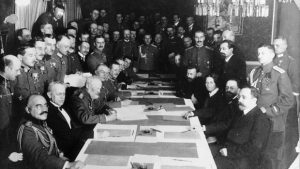
The end came on March 3, 1918, when Russia accepted peace terms that were even more harsh than those originally suggested by Germany. Russia would lose Poland, Lithuania, and the Baltic states of Estonia, Livonia, and Courland to Germany. To further devastate Russia’s hopes, Finland and the Ukraine saw Russia’s weakness as an opportunity to declare their independence. In all, Brest-Litovsk deprived Lenin’s new state of one million square miles of territory and one-third of its population, about 55 million people. Sometimes, it’s better to settle, rather than risk a loss far more devastating.
 I always knew that my uncle, George Hushman served in the United States Navy during World War II, but like many of the men who fight in wars, discussing what happened during their deployment is something that few want to talk about. My family spent quite a bit of time with Uncle George and Aunt Evelyn, who was my mom’s sister, and their family, but in all those visits, I never heard my dad, Allen Spencer, or my Uncle George ever talk about their time in the war. In fact, had it not been for an old picture of the two couples going to the Military Ball, I don’t think I would have even known what branch of the military Uncle George was in.
I always knew that my uncle, George Hushman served in the United States Navy during World War II, but like many of the men who fight in wars, discussing what happened during their deployment is something that few want to talk about. My family spent quite a bit of time with Uncle George and Aunt Evelyn, who was my mom’s sister, and their family, but in all those visits, I never heard my dad, Allen Spencer, or my Uncle George ever talk about their time in the war. In fact, had it not been for an old picture of the two couples going to the Military Ball, I don’t think I would have even known what branch of the military Uncle George was in.
Recently, while researching my family history, I came across some Muster Rolls for the United States Navy, for one USS Gurke. The USS Gurke was a DD Type destroyer whose mission was to provide anti-submarine and anti-surface defense to other surface forces. The Gurke is one of 103 Gearing Class destroyers that were built at 8 different shipyards. It was originally laid down as USS John A. Bole in October of 1944, but was renamed USS Henry Gurke (DD-783) prior to her launching on February 15, 1945 at the Todd-Pacific Shipyards, Inc, in Tacoma, Washington. The ship’s sponsor was Mrs. Julius Gurke, mother of Private Gurke, for whom the ship was named. The destroyer was commissioned 12 May 1945, under the command of Commander 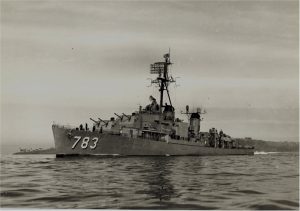 Kenneth Loveland. It was to this ship that my Uncle George was assigned beginning May 12, 1945. Prior to that he had been a S2c V6 on the USS LCI (G) 23, which was a transport ship.
Kenneth Loveland. It was to this ship that my Uncle George was assigned beginning May 12, 1945. Prior to that he had been a S2c V6 on the USS LCI (G) 23, which was a transport ship.
On the Gurke, Uncle George had a rating of S1c V6. I wasn’t sure what that meant, but I’m sure that any navy veteran would know. A V6 is a person who volunteered in World War II. As a V6 they had to be discharged by six months after the war was over. An S1c was a seamen first class. So now I knew what my uncle did during the war. Seaman first class was the rank right below a Petty Officer. The Seaman did a variety of jobs onboard the ship and could have worked anywhere on the ship. I suppose it would be a rank similar to the private, or in non-military verbiage, a laborer. That was the rank that many men went into the navy with, but a seaman first class was no longer a trainee. He had been trained to do his duties, and didn’t have to be told.
After a shakedown along the West Coast, the Gurke sailed for the Western Pacific August 27, 1945, reaching  Pearl Harbor on September 2nd. From there she continued west to participate in the occupation of Japan and former Japanese possessions. Returning to home port of San Diego, in February 1946, the Gurke participated in training operations until September 4, 1947, when she sailed for another WestPac cruise. Two further WestPac cruises, alternating with operations out of San Diego, and a cruise to Alaska in 1948 aiding the celebration of the 50th anniversary of the Yukon gold rush, filled Gurke’s schedule until the outbreak of the Korean War. Of course, I assume that upon Gurke’s return to her home port of San Diego, my uncle was either assigned to another ship, was at home port, or discharged. I am very proud of his service. Today is Uncle George’s 93rd birthday. Happy birthday Uncle George!! Have a great day!! We love you!!
Pearl Harbor on September 2nd. From there she continued west to participate in the occupation of Japan and former Japanese possessions. Returning to home port of San Diego, in February 1946, the Gurke participated in training operations until September 4, 1947, when she sailed for another WestPac cruise. Two further WestPac cruises, alternating with operations out of San Diego, and a cruise to Alaska in 1948 aiding the celebration of the 50th anniversary of the Yukon gold rush, filled Gurke’s schedule until the outbreak of the Korean War. Of course, I assume that upon Gurke’s return to her home port of San Diego, my uncle was either assigned to another ship, was at home port, or discharged. I am very proud of his service. Today is Uncle George’s 93rd birthday. Happy birthday Uncle George!! Have a great day!! We love you!!
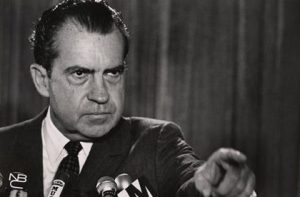 On December 13, 1972, peace talks with North Vietnam broke down, and President Richard Nixon announced that the United States will begin a massive bombing campaign to break the stalemate. Nixon was furious, and order the plans drawn up for retaliatory bombings of North Vietnam, and Linebacker II was the result. The bombings began on December 18, 1972 and continued until December 29, 1972. Beginning with American B-52s and fighter-bombers dropping over 20,000 tons of bombs on the cities of Hanoi and Haiphong. The United States lost 15 of its giant B-52s and 11 other aircraft during the attacks. North Vietnam claimed that over 1,600 civilians were killed. After eleven days of the massive pounding, the North Vietnamese agreed to resume the talks.
On December 13, 1972, peace talks with North Vietnam broke down, and President Richard Nixon announced that the United States will begin a massive bombing campaign to break the stalemate. Nixon was furious, and order the plans drawn up for retaliatory bombings of North Vietnam, and Linebacker II was the result. The bombings began on December 18, 1972 and continued until December 29, 1972. Beginning with American B-52s and fighter-bombers dropping over 20,000 tons of bombs on the cities of Hanoi and Haiphong. The United States lost 15 of its giant B-52s and 11 other aircraft during the attacks. North Vietnam claimed that over 1,600 civilians were killed. After eleven days of the massive pounding, the North Vietnamese agreed to resume the talks.
A few weeks later, the treaty was finally signed and the Vietnam War ended. This also ended the United States’ role in a conflict that seriously damaged the domestic Cold War consensus among the American public. The 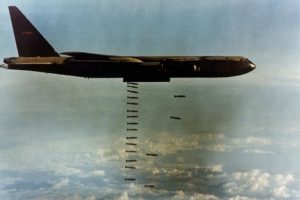 impact of the so-called “Christmas Bombings” on the final agreement remains a question. Some historians have argued that the bombings forced the North Vietnamese back to the negotiating table. Others thought that the attacks had little impact, other than the additional death and destruction they caused. Even the chief United States negotiator, Henry Kissinger, was reported to have said, “We bombed the North Vietnamese into accepting our concessions.” The chief impact may have been in convincing America’s South Vietnamese allies, who were highly suspicious of the draft treaty worked out in October 1972, that the United States would not desert them. Despite the forced return to the table, the final treaty did not include any important changes from the October draft.
impact of the so-called “Christmas Bombings” on the final agreement remains a question. Some historians have argued that the bombings forced the North Vietnamese back to the negotiating table. Others thought that the attacks had little impact, other than the additional death and destruction they caused. Even the chief United States negotiator, Henry Kissinger, was reported to have said, “We bombed the North Vietnamese into accepting our concessions.” The chief impact may have been in convincing America’s South Vietnamese allies, who were highly suspicious of the draft treaty worked out in October 1972, that the United States would not desert them. Despite the forced return to the table, the final treaty did not include any important changes from the October draft.
I believe that the bombings were instrumental in bringing the North Vietnamese back to the table, but I sometimes wonder what the emotional impact was on the men involved in the bombings. It’s hard to wage war  at anytime, but when you think of the Christmas season, and all it stands for, I must have been terribly hard to drop those bombs and end the lives of so many on what should have been a joyous holiday. I’m sure the men thought of their own families and children too. Of course, I don’t know what the North Vietnamese did about Christmas, or if it was anything to them at all, but it was to our men, and it seems to me that it would be very hard to take lives on that day…especially when, in times past it seems like it was common practice to have a cease fire on that day, but then I guess that can’t always be the case. Someone somewhere would insist on breaking the day of peace, because that is what war is all about, after all.
at anytime, but when you think of the Christmas season, and all it stands for, I must have been terribly hard to drop those bombs and end the lives of so many on what should have been a joyous holiday. I’m sure the men thought of their own families and children too. Of course, I don’t know what the North Vietnamese did about Christmas, or if it was anything to them at all, but it was to our men, and it seems to me that it would be very hard to take lives on that day…especially when, in times past it seems like it was common practice to have a cease fire on that day, but then I guess that can’t always be the case. Someone somewhere would insist on breaking the day of peace, because that is what war is all about, after all.
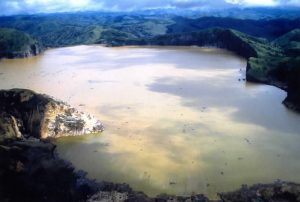 We have all heard about volcanic eruptions, seen photos or video of one, or maybe even seen one in person. They are an event that makes it hard to take your eyes off of the scene. There are volcanos that erupt often, and there are those that haven’t erupted in hundreds of years. And, there are volcanos that erupt under the ocean. But…there is a rare type of eruption, that is, in fact so rare that it has only been observed twice, although it may have happened elsewhere. It is called a Limnic Eruption.
We have all heard about volcanic eruptions, seen photos or video of one, or maybe even seen one in person. They are an event that makes it hard to take your eyes off of the scene. There are volcanos that erupt often, and there are those that haven’t erupted in hundreds of years. And, there are volcanos that erupt under the ocean. But…there is a rare type of eruption, that is, in fact so rare that it has only been observed twice, although it may have happened elsewhere. It is called a Limnic Eruption.
A limnic eruption, also called a lake overturn, is a rare type of natural disaster in which dissolved carbon dioxide (CO2) gas suddenly erupts from deep lake waters. The eruption forms a gas cloud that can suffocate wildlife, livestock, and humans. It can also cause tsunamis in the lake as the rising CO2 displaces the water. Scientists believe earthquakes, volcanic activity, or explosions can be a trigger for such an explosion. Lakes in which limnic activity occurs are known as limnically active lakes or exploding lakes. Some clues as to limnically active lakes include: CO2 saturated incoming water, a cool lake bottom indicating an absence of direct volcanic interaction with lake waters, an upper and lower thermal layer with differing CO2 saturations, and proximity to areas with volcanic activity, all of which are possible indicators of a limnic lake.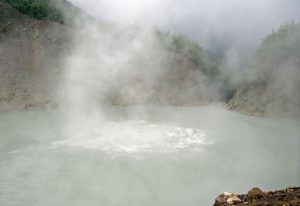
After a Limnic explosion the water left in the lake is filled with debris and massive amounts of dissolved CO2. To date, this phenomenon has been observed only twice. The first was in Cameroon at Lake Monoun in 1984, causing the asphyxiation and death of 38 people living nearby. A second, deadlier eruption happened at neighboring Lake Nyos in 1986, this time releasing over 80 million cubic meters of CO2 and killing around 1,700 people and 3,500 livestock, again by asphyxiation. When the explosion occurred in Lake Nyos, a geyser of water shot out of the lake reaching a height of 300 feet. A small tsunami rushed over the land, followed by a carbon dioxide blast that asphyxiated people up to 15 miles away. Scientists believe limnic explosions are caused by pockets of magma under lakes, which leak and cause carbonic acid to form. In an effort to prevent future explosions, degassing tubes were installed in Lake Nyos to allow the gas to leak at a safe rates.
A third lake, Lake Kivu, on the border between the Democratic Republic of the Congo and Rwanda, also contains massive amounts of dissolved CO2, and it is believed that Limnic eruptions have occurred there too.  Sample sediments from the lake were taken by professor Robert Hecky from the University of Michigan, which showed that an event caused living creatures in the lake to go extinct approximately every thousand years, and caused nearby vegetation to be swept back into the lake. Limnic eruptions can be measured on a scale using the concentration of CO2 in the surrounding area. Due to the nature of the event, it is hard to determine if limnic eruptions have happened elsewhere. The Messel pit fossil deposits of Messel, Germany, also show evidence of a limnic eruption there. Among the victims of that eruption are perfectly preserved insects, frogs, turtles, crocodiles, birds, anteaters, insectivores, early primates and paleotheres.
Sample sediments from the lake were taken by professor Robert Hecky from the University of Michigan, which showed that an event caused living creatures in the lake to go extinct approximately every thousand years, and caused nearby vegetation to be swept back into the lake. Limnic eruptions can be measured on a scale using the concentration of CO2 in the surrounding area. Due to the nature of the event, it is hard to determine if limnic eruptions have happened elsewhere. The Messel pit fossil deposits of Messel, Germany, also show evidence of a limnic eruption there. Among the victims of that eruption are perfectly preserved insects, frogs, turtles, crocodiles, birds, anteaters, insectivores, early primates and paleotheres.

